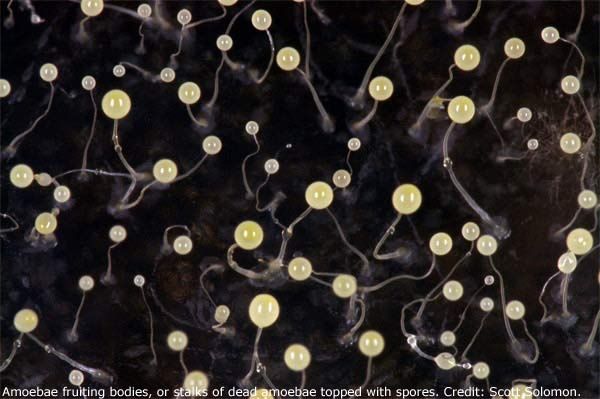Slime Molds Pack a Lunch Before They Travel


When striking out for new territory, one species of single-celled amoeba runs through a checklist: Secrete a chemical signal to attract other amoebas, mass together into a multicellular "slug," and prepare to slither off to new pastures. Oh, and don't forget to pack a lunch.
A new study finds that some strains of this social amoeba, called Dictyostelium discoideum, pack bacteria snacks with them before they travel. Once the amoebae reach their destination, they seed the area with the bacteria, ensuring any amoeba offspring will have plenty to eat.
Though the amoebae don't plow, hoe, or otherwise tend their bacterial crop, the behavior is a form of primitive farming, Rice University researchers reported Jan. 20 in the journal Nature.
Bacterial harvest
Social amoebae, better known as slime molds, have long been known for their migratory ways. When food gets scarce, they amass and travel to new territory, where they reproduce by sending out spherical fruiting bodies containing spores.

In the new study, the researchers collected 35 strains of wild D. discoideum slime molds from Virginia and Minnesota and ran lab experiments on them. The studies showed that about one-third of the strains don't eat themselves out of house and home before traveling. Instead, they save some bacteria for the trip. It's a strategy that's not without costs.
"We now know that primitively social slime molds have genetic variation in their ability to farm beneficial bacteria as a food source," George Gilchrist, program director in the National Science Foundation's Division of Environmental Biology, which funded the research, said in a statement. "But the catch is that with the benefits of a portable food source comes the cost of harboring harmful bacteria."
Sign up for the Live Science daily newsletter now
Get the world’s most fascinating discoveries delivered straight to your inbox.
Farming your own bacteria also did little good when the slime mold found a new, bacteria-rich site. In these fertile areas set up in the lab, non-bacteria-farming slime molds reproduced better than those that brought their food with them.
But when slime molds found themselves on lean land, packing a lunch was advantageous. In barren areas, non-farming slime molds produced almost no spores, the researchers found, while farmers proliferate.

The first farmers
The findings could help researchers understand the origins of farming. Agriculture isn't just the domain of humans: Some beetles carve out tunnels in trees to farm fungi, and damselfish crop algae for food, much like a gardener prunes a bush.
The ancestors of the slime molds were some of the earliest colonizers of dry land, wrote Jacobus J. Boomsma, a biologist at the University of Copenhagen, in an editorial accompanying the paper. That means their primitive version of farming may be the first example of the behavior.
"If this farming symbiosis turns out to be ancient, our new understanding of Dictyostelium biology could be summed up in a lyric of the rock band Metallica," Boomsma, who was not involved in the study, wrote. "To paraphrase: wherever they roamed, they redefined the unknown, by themselves but not alone."
You can follow LiveScience Senior Writer Stephanie Pappas on Twitter @sipappas.

Stephanie Pappas is a contributing writer for Live Science, covering topics ranging from geoscience to archaeology to the human brain and behavior. She was previously a senior writer for Live Science but is now a freelancer based in Denver, Colorado, and regularly contributes to Scientific American and The Monitor, the monthly magazine of the American Psychological Association. Stephanie received a bachelor's degree in psychology from the University of South Carolina and a graduate certificate in science communication from the University of California, Santa Cruz.











